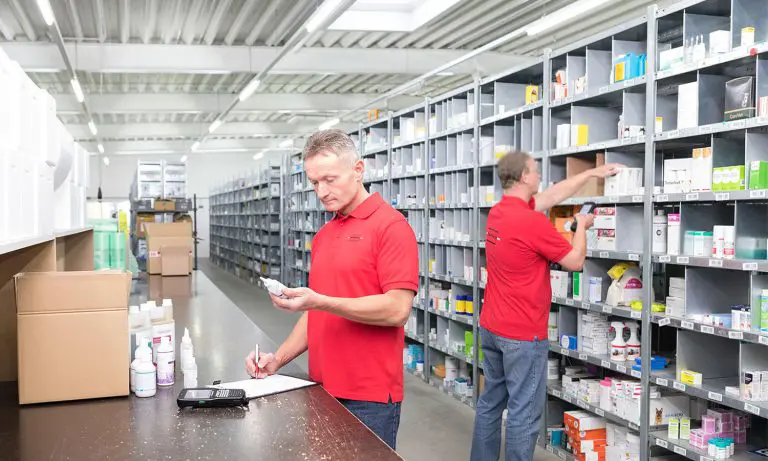From the central warehouse at the Universitair Ziekenhuis Gent, 364 internal customers, spread across 727 different delivery addresses, are supplied on a weekly basis with a range of both medical and non-medical equipment.
In total, this means stocking around 35,000 storage spaces across the various departments of the hospital.
In order to run the automatic replenishment process more efficiently, UZ Gent decided to invest in Slimstock’s inventory management solution, Slim4. Today, Slim4 is utilised to gain greater insight into the stock levels at the central warehouse. However, as part of the next phase, the solution will be introduced to help create a more dynamic automated replenishment process. Given the time savings and enhanced transparency created by Slim4, Pieter Swinnen, head of supply chain at the Universitair Ziekenhuis Gent, is optimistic that the next phase will be equally as successful.
The central warehouse
Both the automated replenishment process and the distribution to pharmacies as well as the central warehouse are all under the jurisdiction of the supply chain department at UZ Gent. From the central warehouse at Universitair Ziekenhuis Gent (UZ Gent), 364 internal customers, spread across 727 delivery addresses, are supplied on a weekly basis with a range of medical and non-medical equipment. Busy services such as the operating theatre and intensive care unit may be supplied up to three times a week. For most services, replenishment is based on an automated static reorder point system in SAP. Further to this, a limited number of services manage their own inventory and place orders into SAP via an online catalogue.
Inconsistient consumption rates
By the end of this year, 90% of both sterile and non-sterile consumables will be managed by the automatic replenishment system. “As a result of the time this will save us, we will be able to focus more time on managing everything else such as controlling the stock rotation of items with short shelf lives, phasing out end of life items and even ensuring that the storage spaces themselves are well maintained,” says Pieter Swinnen.
In total there are around 35,000 storage spaces across the hospital. “A storage box can vary in size and could even include anything down to a small container. For each item we need to determine a minimum and maximum reorder point. The fact that not all articles behave the same way at every storage location, makes this process very complicated.
For example, while an article may be fast moving in one location, in a different department of the hospital, the item may rotate far more slowly. Furthermore, the consumption rate of an article is not consistent and can fluctuate hugely. For example, the consumption rate of an article can be influenced by seasonality but also by the individual preferences of the doctors. Furthermore, the product lifecycles can also be influenced by the number of new product introductions which come about as a result of the contracts UZ Gent agrees with its suppliers.
Automatic optimisation of reorder point
In the long term, Universitair Ziekenhuis Gent hopes to utilise Slim4 to automate their entire supply chain. “Flexible data management remains a major challenge within our ERP system; there is no forecasting functionality and there is also no way to classify the different product types based on the deviation between the actual consumption rate and the forecast. This is why we decided to invest in a best-of-breed solution like Slim4.”
More manageable
Through helping to enhance visibility and save the team time, Slim 4 has already proven its value to UZ Gent. “We can easily request an overview of all the articles on a monthly basis. Furthermore, at a glance we can now see which products differ from their profile. Before Slim 4, analysing this data took hours. As a result of the transparency created by Slim4, we can be far more responsive and take action to proactively avoid stock-outs.”
The implementation itself went smoothly. However, finding the balance in functionality between inventory management and warehouse management took some thinking. “Before the implementation, we organized several meetings with Slimstock to determine which concept would be the best option for us. After all, we needed to understand how can we could utilise Slim4 to support our business model? How do we define a storage location? As soon as it was clear how we wanted to shape all these parameters within Slim4, the implementation itself did not take much time at all.
New services
The whole purpose of this project was to achieve a more refined product range and a higher level of availability. “Achieving a reduction in inventory reduction is not the goal as such. It is more important that we get most out of the time and space available to us and that we obtain a better product range as well as a higher level of availability. In any case, it would be difficult to reduce the volume of stock we hold as the free space would be immediately occupied by another article. Through utilising Slim4, we have a clear view of the consumption rates of each of the different product categories and we can easily determine which articles are the most important to keep in stock. Another advantage is that, when phasing out an article and replacing it with a new one, we can use the historic demand as a starting point to determine the profile of the new item,” explains Peter Swinnen.
By using Slim4, Peter Swinnen and his team are now better positioned to respond to the demands of the internal customers. “Previously, the department of intensive care received a list from the Microsoft Dynamics Axapta ERP system showing the behaviour of their twenty main products. They used it to keep monitor their consumption rate of article. Extracting the same information from SAP did not turn out not to be as easy. It took a lot of work to adjust, group and filter the data. In contrast, with Slim4 all this data is within easy reach. By using a simple Excel tool, the departments receive the required data from Slim4, allowing each team to create a summary of the most important items, both in terms of volume and value. Being able to work with Slim4 in this way has exceeded all of our expectations.” concludes Peter Swinnen.







